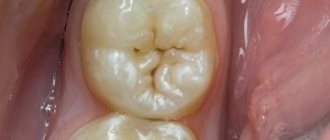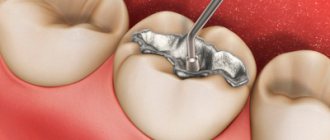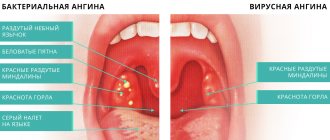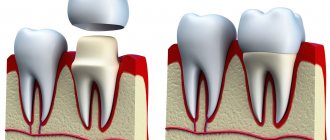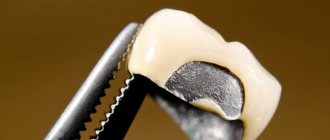Dental caries is the most common dental disease, affecting more than 90% of people worldwide. Caries, which is not treated on time, leads to tooth decay and severe complications, so if you notice any signs of this disease, do not delay and contact your dentist. Cervical caries has its own classification - according to the stage of development, as well as according to the location. If carious lesions affect the cervical part of the tooth, such dental caries is called cervical caries.
How does cervical caries differ from other forms of caries, and how is it treated in dentistry? We will talk about this in detail in this material! After reading the article, you will learn how cervical caries develops, what causes it, what methods are used to treat caries in this form and how much it costs to cure cervical caries in Moscow.
Calculate the cost of treatment by taking a short test in 20 seconds!
Do not delay your treatment, because in this matter time plays against us.
Cervical caries: what is it?
The neck of the tooth is the name given to the place where the tooth comes into contact with the gum. Caries that forms in this area is usually referred to as cervical caries, and it should be noted that this form of caries occurs quite often, because the enamel on the neck of the tooth is quite thin and vulnerable, insufficiently mineralized. Cervical caries occurs in people of all ages and the most common reason for its occurrence is irregular oral hygiene.
Cervical caries in the initial stages of development is quite difficult to notice, because it manifests itself as a small bright spot. Many people do not pay any attention to this spot until the tooth begins to hurt or the damage becomes more significant and noticeable. Meanwhile, it is necessary to start treating cervical caries urgently, because from the neck of the tooth the infection can easily get into the pulp and the inside of the tooth, and this is fraught with complications such as pulpitis and periodontitis.
USEFUL TO KNOW: Pulpitis and periodontitis are quite serious complications of caries that can lead to tooth loss. Treatment of these complications of cervical caries is an unpleasant, slow and quite expensive process, so never start caries and consult a doctor at the first sign!
Traditional methods in the fight against cervical caries
In order to get rid of cervical caries, you can also use folk remedies. However, you need to understand that they can only help at the initial stage of progression of this disease, when a small stain has just appeared on the tooth.
What means are suitable for this?
- Decoction of onion peels: boil the peels, let them sit overnight and rinse at least after each meal;
- Propolis: rinse with a solution (four teaspoons of pharmaceutical solution per glass of warm water) three times a day;
- Sage: pour a glass of water over a spoonful of dried leaves, leave for an hour and rinse as often as possible.
- Melissa: pour four tablespoons of the herb with a glass of boiling water, leave for an hour and rinse after eating.
Before using any of these methods, it would be a good idea to undergo an examination by a dentist and consult with him about the most effective treatment method in this case.
Why does cervical caries appear and develop?
As we wrote above, the tooth enamel in the cervical area is quite thin and vulnerable, in addition, the cervical area of the tooth is quite difficult to properly clean from plaque during cleaning. And the remaining plaque is a favorable environment for the proliferation of different types of pathogenic microorganisms, including carious bacteria.
The vital activity of these bacteria leads to the active formation of lactic acid, which destroys tooth enamel and, as a result, cervical caries occurs. Also, the occurrence of cervical caries can be caused by the abuse of abrasive pastes, taking certain medications, and chronic general diseases of the body. An unbalanced diet can also be a factor provoking the development of cervical caries, therefore, even while following diets that are so fashionable these days, it is important to ensure that the body receives all the necessary vitamins and minerals!
How can deep caries be cured?
A disease such as deep caries can be treated in one or two visits.
The first option is carried out according to this scheme:
- The doctor numbs the affected tooth with a local anesthetic.
- Opens the carious cavity and, using a drill, cleans it of dead and diseased tissue until dense walls and bottom remain.
- If caries is complicated by pulpitis, endodontic treatment is carried out, that is, the dental canals are filled.
- To treat inflammation, isolate the sensitive pulp from the effects of filling material, and build up dentin, a therapeutic or insulating pad is placed at the bottom of the cavity.
- After all the above manipulations, the tooth is closed with a filling.
Treatment in two visits is carried out according to this scheme.
During the first visit, pain relief is performed, the cavity is opened and the affected tissue is removed. A medical pad is placed in the cavity and closed with a temporary filling. On the second visit after a few days or weeks, if the patient has no complaints, the temporary filling is replaced with a permanent one.
Treatment in two visits is considered preferable because it is possible to observe the condition of the tooth before installing a permanent filling. If pain, discomfort and other symptoms occur, additional therapeutic procedures can be performed to ensure that the affected tissue is completely removed. When treating a tooth in two visits, complications and relapses of caries occur much less frequently.
Symptoms and types of cervical caries
Symptoms of cervical caries may vary depending on the stage of its development. Therefore, below we will consider the stages of development of cervical caries and describe the signs characteristic of each of them.
Cervical caries in the spot stage
At this phase of caries development, a small dark or light spot may appear in the cervical area of the tooth. The pain of the patient with cervical caries does not bother the spots.
Superficial cervical caries
At this stage of cervical caries, the surface layers of tooth enamel are destroyed. It may become rough and uneven to the touch. Increased sensitivity of the diseased tooth to temperature factors - too hot or cold food - may also occur.
Middle cervical caries
The carious lesion of the tooth increases in size, the dentin of the tooth becomes increasingly soft. But at the same time, the destructive process at this stage of cervical caries has not yet reached the pulp. A person may experience tooth pain when brushing their teeth or biting into food. But this pain goes away quite quickly, which is why people are in no hurry to treat caries, thinking that the tooth will go away on its own.
Deep cervical caries
Destruction at this stage of caries reaches the pulp and the risks of pulpitis become extremely high.
In a tooth with advanced caries, severe pain may occur when the tooth comes into contact with food. The tooth begins to hurt especially badly if a piece of food gets into the carious cavity. After eliminating the irritant, the pain may go away. Cervical caries also has another form, which dentists call circular caries. It affects several teeth in a row at once, and carious destruction runs along the tooth at the neck like a belt, that is, from all sides. It is very, very difficult to treat circular caries!
The form and stage of development of cervical caries are determined by the dentist during diagnostic measures.
Causes of basal caries
The cause of cervical caries is the presence in the root zone of favorable conditions for the life of bacteria. These bacteria produce an acid that leaches calcium from the enamel, making it weak. Through damaged enamel, bacteria enter the internal tissues, the infection spreads further and eventually reaches the pulp - the neurovascular bundle.
Risk factors
- improper use of a toothbrush - the bristles should begin to move from the gums to the cutting edge of the crown, and not vice versa (otherwise the plaque in the root zone is not removed);
- brushing your teeth with a brush that is too hard, which has an aggressive effect on the enamel and makes it vulnerable to microbes;
- lack of self-cleaning, the cervical part does not participate in the chewing process, which means it does not come into contact with other teeth and is not cleaned naturally - by solid parts of food;
- fillings and crowns that injure the gums and provoke inflammatory processes;
- gum diseases, in which deep periodontal pockets are formed - gaps between the teeth and gums in which plaque accumulates;
- root exposure (with periodontitis and periodontal disease);
- wearing orthodontic appliances, which make it impossible to thoroughly clean the teeth in the cervical area.
Radical caries on x-ray
How is cervical caries diagnosed?
If you are careful, you can determine for yourself whether you have cervical caries or not. To do this, you need to brush your teeth well and then carefully examine their cervical area in sufficient lighting. Any spots in the area of the neck of the tooth indicate that the tooth is affected by cervical caries, and it is urgently necessary to treat it.
In a clinical setting, not only visual examination, but also professional techniques are used to diagnose cervical caries. Among them:
Vital staining technique
This technique for diagnosing cervical caries involves cleaning dental surfaces from plaque, and then treating them with a special coloring solution. A few minutes after application, the solution is washed off with water and if colored spots remain on the tooth enamel in the area of the tooth neck, this indicates the development of cervical caries.
Transillumination
This method for diagnosing cervical caries uses a beam of cold light, which is absolutely harmless to tooth enamel, but at the same time clearly shows the specialist carious damage.
Light diagnostics of caries is carried out in a dark room and within a couple of minutes allows you to make an accurate diagnosis! Another method for diagnosing cervical caries is laser diagnostics. When a carious lesion is detected, it will be displayed on the device display, and the device will also emit a characteristic sound signal. Laser diagnostics of cervical caries is an expensive pleasure, but at the same time the most effective!
Based on the diagnostic data and the stage of development of cervical caries determined with its help, the most effective method of its treatment is selected.
Signs of caries
A visit to the dentist can help determine that a carious process has begun at the neck of the tooth, so it is important not to neglect routine examinations.
At home, a thorough examination of the teeth will help detect the development of cervical (cervical) caries. The occurrence of pathology is indicated by:
- the appearance of a carious cavity on the neck of the tooth;
- reaction to stimuli;
- white spots on the tooth;
- lightening or darkening of the enamel in the area of the tooth neck.
The appearance of at least one of the symptoms is a reason to sign up for an examination. You shouldn’t delay going to the doctor: the more serious the stage, the more difficult the treatment.
Stages of cervical caries
Is it painful to treat cervical caries?
Is it painful to treat cervical caries? This question is often asked by patients to doctors. You can answer it as follows: if cervical caries is diagnosed at the spot stage, then it can be treated without drilling the tooth, using special techniques and medications. In this case, treatment of dental caries will be absolutely painless and will not cause you any discomfort.
But do not be afraid to treat cervical caries at other stages. Firstly, treatment of medium and deep dental caries is always carried out under local anesthesia, which completely eliminates all unpleasant sensations, and secondly, if you have a panicky fear of dentists, you can cure cervical dental caries in your sleep - under sedation. You will sleep peacefully, and the dentist will perform all the necessary actions for high-quality treatment of cervical caries.
Features of diagnosing deep caries
Advanced caries often has the same clinical picture as pulpitis and some other dental diseases. Therefore, before starting treatment, the doctor must conduct a differential diagnosis and understand which pathology to treat.
Deep caries can be distinguished from focal pulpitis by a number of symptoms. With pulpitis, probing the cavity with a dental probe will cause pain only in one area - in the area of the pulp, while with deep caries pain occurs over the entire surface of the tooth.
The probing procedure will also help to distinguish deep caries from medium ones. On average, it is almost painless, because a fairly thick layer of dentin remains between the sensitive pulp and the bottom of the carious cavity. With a deep form, the tooth reacts to probing with severe pain. The method of electroodontodiagnostics helps to distinguish deep caries from fibrous pulpitis. In most cases, the doctor will order an x-ray to confirm the diagnosis.
Treatment methods for cervical caries
How will cervical caries be treated in dentistry? The answer to this question will depend on the stage of development of cervical caries. Below we will look at the features of treating caries in the cervical area of the tooth, depending on the phase of its development.
Treatment of cervical caries in the spot stage
As we already wrote above, to treat cervical caries of a spot, it is not necessary to drill out the tooth.
At this stage of caries development, special preparations rich in calcium and other minerals beneficial to enamel are used. ICON technology can also be used. USEFUL TO KNOW: By seeking caries treatment in a timely manner, you can maintain the health of your teeth and avoid the procedure of tooth drilling, which is unpleasant for many. In the early stages, caries can be treated without a drill - using special remineralizing drugs and technologies that restore the integrity of tooth enamel!
Superficial cervical caries can also be cured without a drill. The treatment regimen will be similar to the treatment method for cervical caries at the spot stage.
Diagnosis of the disease
Cervical caries can be diagnosed during a dental examination of the oral cavity. The specific location and rough structure of the carious spot make it possible to differentiate the pathology from a wedge-shaped defect and simple caries.
Additionally, instrumental diagnostic methods are used: dental radiography, radiovisiography, transillumination and others. They allow you to assess the degree of penetration of caries into the tooth cavity, see hidden lesions and predict the effectiveness of treatment.
Free consultation on the cost of treatment in our dentistry
Leave a request and the clinic administrator will contact you within 15 minutes!
Treatment of medium and deep cervical caries
When treating medium and deep cervical caries, drilling the tooth is no longer necessary.
To rid a tooth of caries and then restore it with a filling, the dentist must remove all tissue affected by caries. A drill is used for this purpose. But there is no need to be afraid of pain - before starting caries treatment, the doctor will definitely give you an injection of an anesthetic, which will “freeze” the tissues and nerve endings in the area of the diseased tooth and eliminate discomfort. Treatment of medium and deep cervical caries is carried out in several stages:
1. First, the doctor will clean your teeth of plaque. This is necessary to improve the quality of caries treatment in general, to identify all carious lesions and to correctly select the color of the filling material that will be used to restore the tooth in the future.
2. Using a drill, the doctor will remove all tissue destroyed by cervical caries and form a cavity for installing a filling. Before using a drill to drill out a tooth and remove tissues damaged by caries, the patient will be given local anesthesia!
3. The finished cavity is washed with an antiseptic solution, and a rubber dam is placed on the tooth - a special insulating gasket that will protect the treatment area from saliva and moisture.
4. The cavity under the filling is treated with antiseptics and an adhesive composition, which will increase the adhesion strength of the filling and natural tooth tissues.
5. The dentist will install the filling and polish and grind it so that the restoration after caries treatment is invisible.
At this point, the treatment of cervical caries can be considered complete. Upon completion of all treatment procedures, the doctor will give you advice on dental care, which will prevent the recurrence of cervical caries in the future.
USEFUL TO KNOW: Advanced cervical caries requires emergency treatment! The neck of the tooth is located too close to the pulp of the tooth and its root part, and if measures are not taken to treat cervical caries in time, the tooth can be lost. If a complication such as periodontitis develops in a tooth with cervical caries, in 90% of cases the tooth will have to be removed, and the treatment of pulpitis on such a tooth will be long and difficult. In addition, pulpitis on teeth with cervical caries cannot be cured without removing the nerve - a procedure that makes the tooth fragile and vulnerable to external factors.
Clinical researches
The products in the Asept line have proven clinical effectiveness and are therefore sold in pharmacies. For example, multiple clinical studies have proven that regular use of preventive toothpaste ASEPTA ACTIVE for a month can reduce bleeding gums by 60%, improve the overall condition of the oral cavity by 44% and reduce inflammation by 33%.
Sources:
- Clinical and laboratory assessment of the influence of domestic therapeutic and prophylactic toothpaste based on plant extracts on the condition of the oral cavity in patients with simple marginal gingivitis. Doctor of Medical Sciences, Professor Elovikova T.M.1, Candidate of Chemical Sciences, Associate Professor Ermishina E.Yu. 2, Doctor of Technical Sciences Associate Professor Belokonova N.A. 2 Department of Therapeutic Dentistry USMU1, Department of General Chemistry USMU2
- Clinical studies of antisensitive toothpaste “Asepta Sensitive” (A.A. Leontyev, O.V. Kalinina, S.B. Ulitovsky) A.A. LEONTIEV, dentist O.V. KALININA, dentist S.B. ULITOVSKY, Doctor of Medical Sciences, Prof. Department of Therapeutic Dentistry, St. Petersburg State Medical University named after. acad. I.P. Pavlova
- Clinical experience in using the Asepta series of products Fuchs Elena Ivanovna Assistant of the Department of Therapeutic and Pediatric Dentistry State Budgetary Educational Institution of Higher Professional Education Ryazan State Medical University named after Academician I.P. Pavlova of the Ministry of Health and Social Development of the Russian Federation (GBOU VPO RyazSMU Ministry of Health and Social Development of Russia)
Features of installing a filling for cervical caries
With cervical caries, the affected area of the tooth is located as close as possible to the edge of the gum, and therefore saliva, blood, and moisture, which are present in abundance in the oral cavity, can easily enter the treatment area. To eliminate this, a rubber dam is used, but you also need to choose and place the filling material correctly. To do this, the doctor leading the treatment of cervical caries must have both experience and relevant knowledge! The slightest mistakes when processing the tooth and installing the filling can lead to the loss of the restoration, as well as to the recurrence of cervical caries already under the installed filling.
To fill a tooth after treating cervical caries, special heavy-duty composite materials that are resistant to moisture and other external factors are used. The aesthetics of these materials are also excellent, because cervical caries often develops in the area of the front teeth, which are clearly visible when smiling.
USEFUL TO KNOW: Do you want cervical caries to be treated efficiently, and for the installed filling to serve you for as long as possible? Choose the right dental clinic for caries treatment! Remember that a good clinic does not offer its patients low prices, but modern equipment, first-class materials, innovative technologies, and experienced and qualified specialists work in such dentistry!
Symptoms
The appearance of cervical caries can be recognized visually, especially if the lesions are located on the front surface of the teeth on the smile line. When located on the lateral teeth, the disease may be indicated by:
- change in tooth texture at the base - roughness to which food sticks;
- when brushing your teeth and running a brush along the neck, acute short-term pain occurs (electric shock effect);
- acute painful reaction to cold and hot, sour and sweet foods.
Unpleasant sensations can appear even during a conversation on the street, when cold air enters the oral cavity.
Is it possible to cure cervical caries on your own?
Traditional medicine is extremely popular these days, so new recipes for treating various diseases at home regularly appear on the Internet, including supposedly effective methods for treating cervical caries. But, alas, dental caries is not a disease that can be cured without consulting a doctor. No matter how powerful natural antiseptics are, they will not stop the process of tooth destruction under the influence of carious bacteria, especially in cases where cervical caries has developed to a medium or deep stage. At these stages of caries development, it is important to remove all affected tissues and qualitatively treat the tooth with medications, put a filling on it in order to prevent further development of cervical caries. Naturally, all these manipulations can only be carried out in a clinical setting.
And one more important point that you need to know and remember: folk remedies cannot be used uncontrollably. You may be allergic to them, and the use of caustic solutions and mixtures can lead to burns of the soft tissues of the mouth and other sad and serious consequences. As a result, instead of getting rid of caries, you can “earn” yourself pulpitis, poisoning, severe allergies and the need for complex and expensive treatment!
The only thing that can and should be done at home is to prevent the development of cervical caries, and below we will tell you how to do this correctly.
Treatment at home
Treatment of cervical caries at home is possible only at the initial stage - a chalk spot. And only after a preliminary consultation with a dentist! If the condition of the demineralized area of enamel does not cause concern, then the specialist may prescribe the use of drugs based on fluoride and calcium. For example, “Fluorovarnish” is used to treat the affected area according to the instructions, the mouth is rinsed with an aqueous solution of sodium fluoride, and calcium gluconate is taken orally.
During home treatment, regular toothpaste should be replaced with a special one - with a high content of fluoride and calcium. For example, use “PresidentUnique” or “Ftorodent” therapeutic and prophylactic products for daily oral hygiene. They can also be applied locally to the affected area of enamel.
Important! The use of traditional medicine (decoctions, lotions, infusions) does not cure cervical caries, but only slightly relieves pain. This creates the illusion of recovery, but does not solve the problem and leads to aggravation of the pathological process.
Prevention of cervical caries: what needs to be done to avoid the development of the disease?
Successful prevention of cervical caries involves the implementation of a whole range of measures:
1. You must pay the utmost attention to oral and dental hygiene. Good oral hygiene reduces the risk of developing dental caries in any form. To do this, you need to brush your teeth twice a day with properly selected brushes and pastes, use rinses and dental floss, and brushes to clean hard-to-reach places. It is also advisable to rinse your mouth after every meal and especially after eating sweet foods. Two to three times a year, it is necessary to undergo professional oral hygiene procedures at the dentist’s office. This procedure can be combined with a preventive dental examination, which makes it possible to detect cervical caries at the earliest stages of its development. Professional oral hygiene is also one of the most effective measures for the prevention of caries in any of its forms.
2. For oral hygiene to prevent caries, it is not enough to choose the right brush - from time to time it needs to be replaced with a new tool. Old brushes accumulate bacteria and, in addition, their bristles wear out and cease to effectively clean dental surfaces. And plaque is the best environment for the proliferation of carious bacteria!
3. You need to monitor the quality of your diet, because a lack of certain vitamins and minerals can lead to the development of cervical caries. In order to reduce the risk of developing caries, you need to limit your consumption of sweets.
And one more important tip - cervical caries easily spreads to neighboring teeth. Therefore, after successful treatment of cervical caries on one of the teeth, carefully examine the adjacent units. If a stain suddenly appears on them, immediately contact your dentist to remineralize your teeth.
Calculate the cost of treatment by taking a short test in 20 seconds!
Do not delay your treatment, because in this matter time plays against us.
Features of the disease
The cervical form of caries is particularly aggressive and inconspicuous in its early stages. Symptoms of this form of caries can appear when the tooth appears intact at first glance. According to statistics, more than 70% of cases of cervical caries are detected too late, when the root canals are damaged or the neck of the tooth is fractured.
Dentists call root caries the most aggressive form of the disease. This statement is based on three significant factors.
The first factor is specific localization
The neck of the tooth, connecting the root and crown, has the thinnest layer of enamel. In addition, this part is covered by the gingival margin, which is why more bacteria and substances that contribute to the destruction of the hard surface of the teeth accumulate on its surface.
Since the thickness of the enamel on the neck is not large enough, and the degree of its mineralization is lower than on the crown, destruction occurs faster. As a result, caries deepens into the dentin and pulp in a matter of weeks, that is, many times faster than when the crown is damaged.
The second factor is specific distribution
Cervical caries tends to spread the pathological process under the gingival margin. In this case, the lesion not only goes deeper inside the tooth, but also around its circumference. This leads to the breaking off of part of the crown at an early stage of the disease.
Important! When the carious lesion covers the entire surface of the cervix, we are talking about the transition of cervical caries to circular. In this case, it is almost impossible to save the tooth.
The third factor is a blow to aesthetics or the invisibility of caries
When located on the front teeth, cervical caries cannot be hidden: it is clearly visible when talking and especially when smiling. This has an extremely negative impact on the psychological state of the patient.
Cervical caries located on chewing teeth, on the contrary, is often ignored and left without treatment. Therefore, more than 80% of patients with this diagnosis turn to dentists when the disease is complicated by pulpitis and the spread of the inflammatory process to the periosteum.
Prices for treatment of cervical caries in Moscow
How much does it cost to cure cervical caries in Moscow? It is difficult to give a definite answer to this question, because the price of the service will depend on many different factors. In particular, the stage of development of the disease is taken into account. Cervical caries in the spot stage is treated quickly and inexpensively - the price of the service in this case will range from 2000 to 4500 rubles.
If, during the development of cervical caries, the infection managed to penetrate into the tooth canals, the cost of treatment will increase significantly and can range from 6,000 to 10,000 rubles.
There is only one way to find out the exact price for treatment of cervical caries - by visiting the dentist's office. After examination and diagnosis, the specialist will draw up a treatment plan for you with a clear indication of the final price for the service.
Do you need detailed professional advice on the treatment and prevention of cervical caries? Contact our dental clinic in Moscow - Venstom! You can make an appointment with our specialists by calling the contact phone numbers of our clinic or by writing to the chat on our website!
Prevention
Only careful oral hygiene can prevent the occurrence of cervical caries. In addition to brushing your teeth twice a day with toothpastes, it is recommended to use dental floss. To remove plaque from gum pockets and remove hard deposits, you need to visit the dentist twice a year and have your teeth professionally cleaned.
To maintain oral health, it is recommended to include fresh solid vegetables and fruits in your diet: apples, carrots, cabbage, etc. Dairy products as a source of calcium and phosphorus will be beneficial for your teeth.
When the first signs of cervical caries appear, you should make an appointment with a dentist and treat the disease before it becomes complicated by pulpitis.

